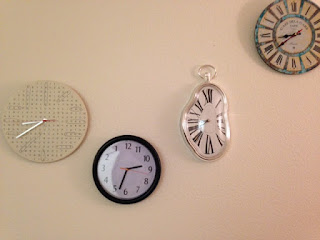As mentioned earlier, I am working at the Google office in Sunnyvale, and I have rented a studio in San Jose that is 8 miles away. The distance to office is comfortable (15 minutes with no traffic, and never more than 30 even with traffic.) The community is lovely and has walking areas and a Starbucks :-).
When I moved in, it was of course bare, and I had the fun and challenge of furnishing. I slept on a blow up mattress for the first couple of weeks, like a teenager. Keeps me young at heart.
I didn’t want to spend much in furnishings - - Our house is in White Plains, and this is just a pied-à-terre. Plus, taking the job at Google has already come with lots of extra expenses...travel home to NY for 10 days every month, additional rent, gas, electric, etc. in California, an additional car….So my goal was to furnish on the cheap, but ensuring the space was pleasant and comfortable for the time that I spend in it.
I started with Craig’s list. I found great and affordable furniture from various posters in the San Jose area. But I still puzzle about the logistics of getting furniture from Craig’s list...how do you pick it up? If we are talking about couches, tables, desks...these don’t fit in my car. Renting a truck? Along with 2 big burly guys that can haul the stuff? And then driving from city to city as needed?
I did find a dining room table and chairs that I liked on Craig’s list from south San Jose (30 minutes away). I had to make 2 trips...one for the chairs, another for the table. The table is solid wood. (lovely!) And heavy (less lovely). When I got back to my apartment, I couldn’t get it out of the car. I found a burly guy in the garage area (works for Facebook) who helped me get it out of the car and to my apartment. And then my neighbor Ajay next door (who works for Apple) helped me assemble it. (At the time I didn’t have tools; now I do.) So this was not a model I wanted to replicate for all the furniture.
My colleague Michelle pointed me to a San Francisco startup, moveloot.com. Sort of like an upscale Craig’s list, that *delivers.* And if you have any, they will take your old furniture, and pay you something if they sell it. So that’s how I did much of the rest of the furniture, supplemented by other online shoppng for a new mattress, bed coverings, etc. I got some of the artwork on Amazon, and at Goodwill.
I had the clever idea of decorating the wall above my desk with interesting clocks. (Shout out here to our friend John Pitrelli, who once upon a time collected unusual clocks.) I got one clock with the time displayed as a word-finding game, one “melting” clock, and one that runs *backwards*. Fun! What I didn’t take into account is that all night long, there is a chorus of tick-tocks. Lulls me to sleep….








